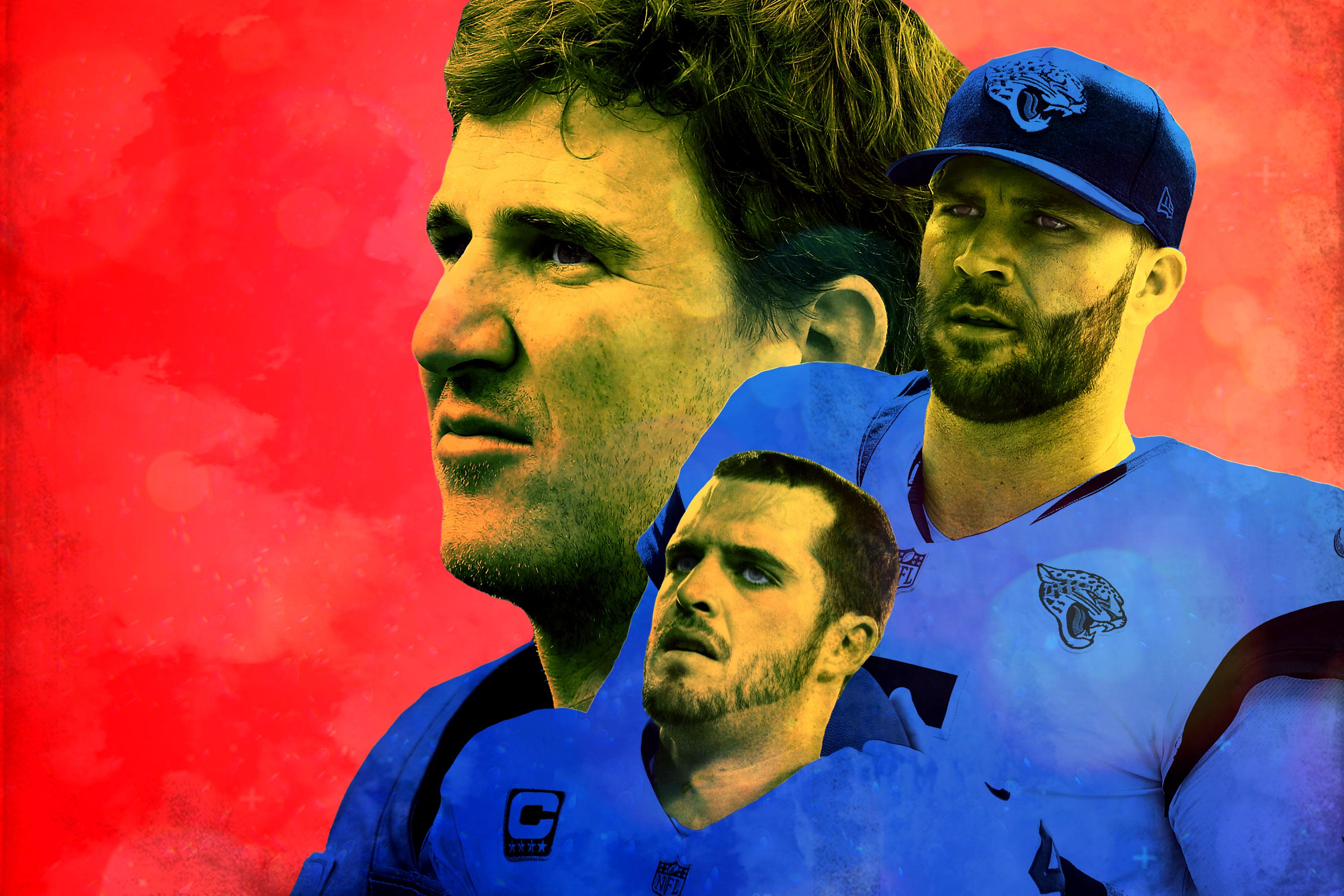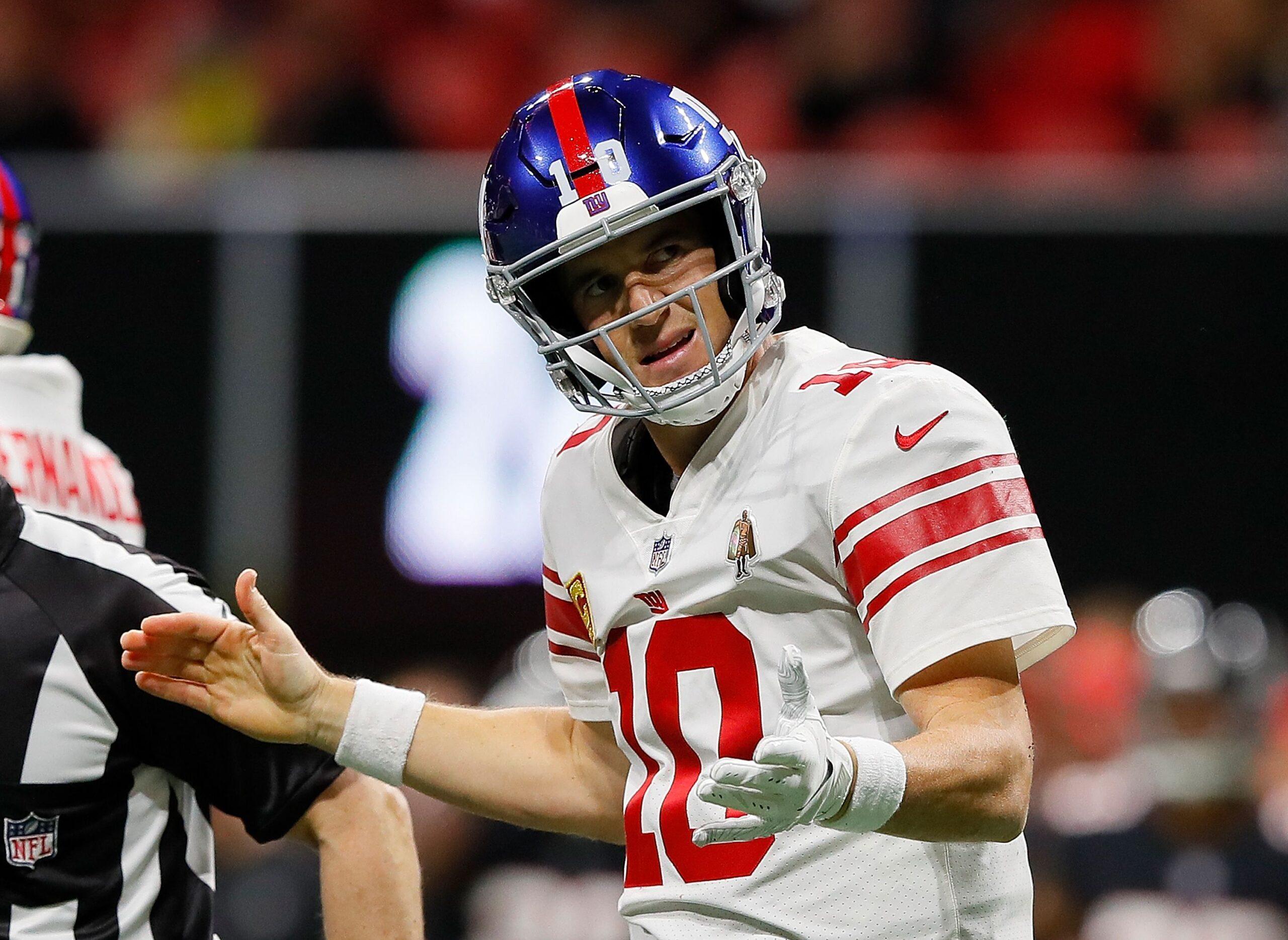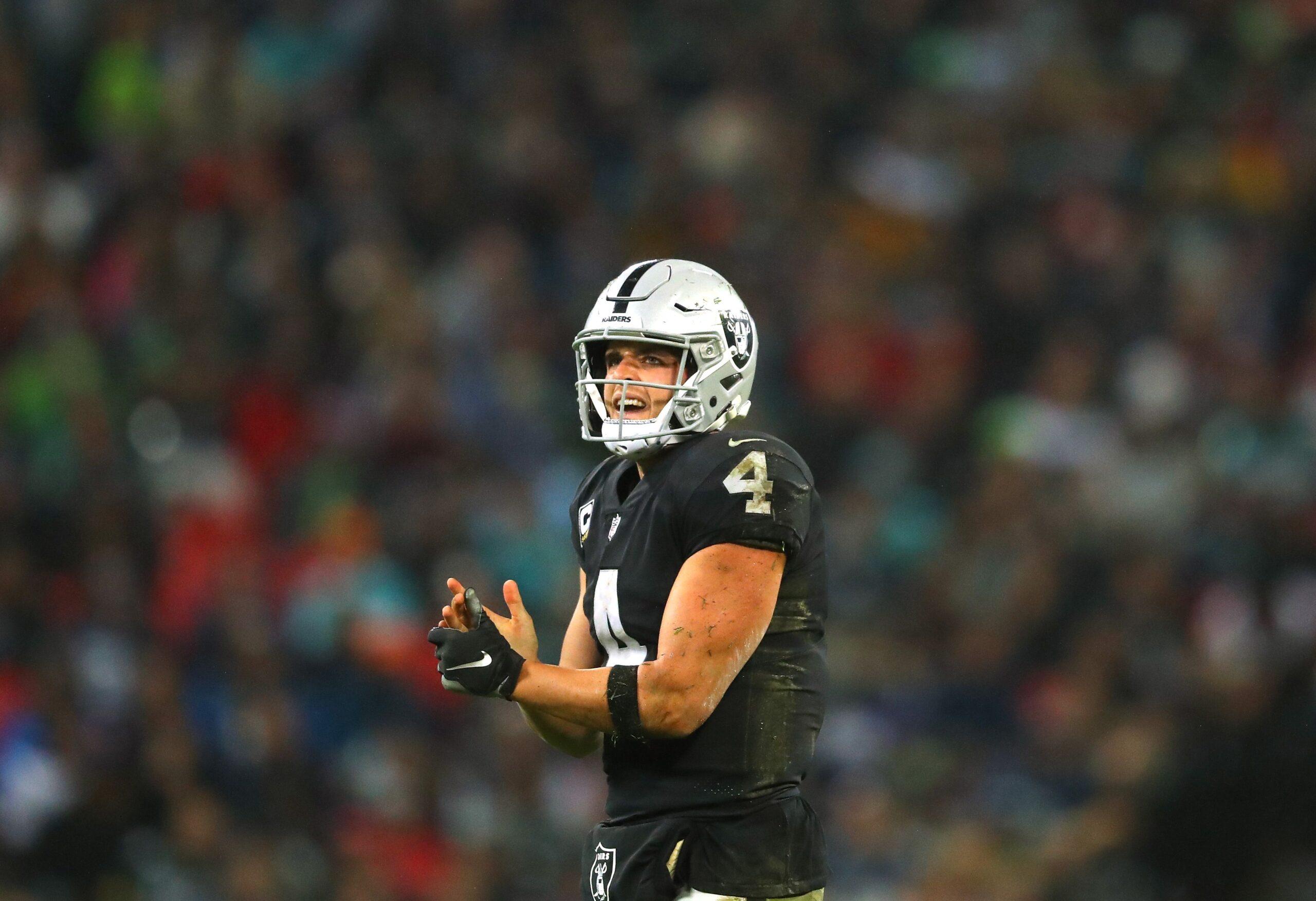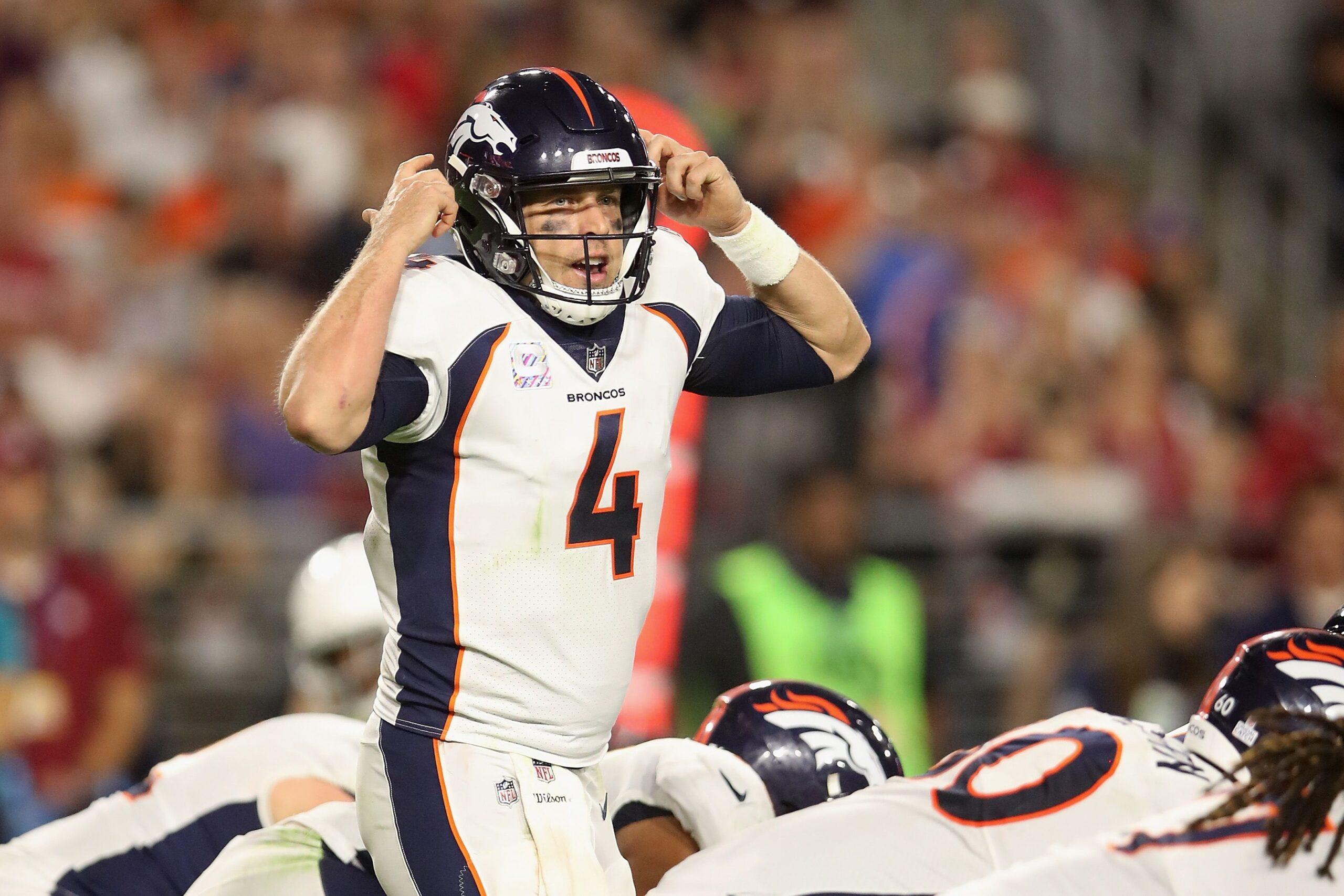
Late October may seem like an odd time to start predicting next spring’s quarterback carousel, but the past week has been filled with speculation about signal-callers who could be on the move. Eli Manning panic has fully taken hold in the tristate area. Blake Bortles was sent to the bench during Jacksonville’s loss to Houston last Sunday. Derek Carr took to Twitter to defend himself against claims that on-field crying created a rift in the Raiders locker room. (I still can’t believe that last one is true.)
As the rumor mill churns and the writing on the wall begins to materialize, let’s take stock of the seven teams that might be ready to make a change at quarterback, either at the trade deadline or before the start of next season.
New York Giants

The Giants are easily the most intriguing team among this group because anything seems to be on the table. Anything except retaining Manning, that is. With Big Blue fresh off a 3-13 campaign and in the midst of a 1-6 season, I can’t imagine the franchise entering next fall with Eli still under center. So as the Giants prepare to move on from the man who helped bring them two Super Bowls, let’s consider the other possibilities in play.
- Trade Manning within the next week. While the front office has begun to strip its roster for parts (a few days after sending cornerback Eli Apple to the Saints, the Giants shipped run-stuffing nose tackle Damon Harrison to the Lions), this option is unlikely. The Harrison deal shows general manager Dave Gettleman is willing to eat some dead money as New York rebuilds, but that mind-set likely has limits. Trading corner Janoris Jenkins or pass rusher Olivier Vernon and taking on the resulting cap burden might be palatable; the pill that’d accompany a Manning trade, though, would be tougher to swallow. If Gettleman deals Manning prior to next week’s deadline, the Giants would eat $16 million in dead money for the rest of 2018, according to Spotrac. That’d be a big blow to a team looking to add resources. The trade market for Manning also appears to be lacking: Outside of the cash-strapped Jaguars, there doesn’t seem to be an organization with sufficient motivation to deal for Manning at his current price.
- Draft a QB with a top-five pick in 2019. Finishing near the bottom of the standings and grabbing a quarterback next spring appears to be the most plausible ending to this saga. Oregon QB Justin Herbert has been a fixture atop recent mocks, but rumors are swirling that he’s hesitant to enter next year’s draft and may choose to return to campus. Even if he does, a prized quarterback prospect or two is likely to emerge during the six months before the 2019 draft. Aside from a few plugged-in draftniks and college football obsessives, no one knew Carson Wentz’s name in October 2015.
Even if running back Saquon Barkley is a transcendent talent—and through seven games, he looks like he is—the Giants’ decision to take him second overall in April when the franchise needed a quarterback was a mistake. Nearly every choice the team made this offseason, like doling out sizable contracts to a left tackle (Nate Solder) and a guard (Patrick Omameh) who has since been benched, was part of a plan to retool in short order. That plan has gone so sour so fast that New York is now in position to pick near the top of the draft again, take its QB of the future, and potentially correct course. Hooray! (I guess.)
- Do something weird. Given the moves that the Giants made in 2018, I’m not ruling out the front office taking a bizarre turn next spring. Gettleman should absolutely purge his roster of expensive veterans to improve the team’s cap health in the short and long term. He should absolutely target a young, cheap QB in the 2019 draft. But let’s consider a wild-card alternative. Case Keenum has only a two-year deal with the Broncos, and found plenty of success working with Giants head coach Pat Shurmur when both were in Minnesota. Gettleman trading for Keenum and his $18 million base salary to be his stopgap QB while grooming a highly drafted rookie would be the type of move we see too often in the NFL.
Jacksonville Jaguars
After benching Bortles in the second half of last week’s 20-7 loss to the Texans, the Jaguars announced that they will stick with the fifth-year passer as their starting quarterback in Week 8. That’s no surprise. Even with his recent struggles, Bortles is Jacksonville’s best option under center. Lampoon the Jags all you want for not bolstering their QB room with a guy like Teddy Bridgewater this offseason—and by the way: you should—but those days are gone. The Saints’ decision to trade a 2019 third-round pick for Bridgewater in August was no accident; he’s staying put in New Orleans. At this point in the calendar, the quarterback trade and free-agency market isn’t particularly appealing.
Jacksonville’s choice to extend Bortles this offseason was complicated, based in part on the quarterback coming off of wrist surgery in January and the fifth-year option in his contract being fully guaranteed in case of injury. Bortles’s new deal—which puts the Jags on the hook for $16.5 million in dead money if they cut him before next season—may be unfortunate, but it was somewhat defensible as a means of freeing up cap space this spring. The problem now is that Jacksonville is already significantly over the cap for 2019. This franchise desperately needs a new quarterback and doesn’t have much recourse through which to get one.
The Jags’ financial commitment to Bortles limits the veteran options available to them. A godfather offer to the Seahawks for Russell Wilson would be tough to pull off financially, as would be trading for less attractive options like Keenum or Ryan Tannehill. And even though Jacksonville has failed to live up to preseason expectations, its roster is way too stacked with talent for this team to tumble to the bottom of the standings and into the top 10 of next year’s draft. Recent history has been relatively kind to teams that have made significant investments to trade up for rookie QBs. The Rams, Eagles, and Chiefs would redo their deals for Jared Goff, Carson Wentz, and Patrick Mahomes II 100 times out of 100. But any trade that involves future first-round picks and a war chest of draft capital comes at a price. Deshaun Watson looked like a steal for the Texans a year ago, but one of the main reasons their offense has struggled this fall is because Houston didn’t have a 2018 first-round pick to bolster its offensive line.
In terms of resources committed, the Jags paying Bortles $21 million in 2019 while devoting a rookie salary to a starting quarterback isn’t the worst outcome imaginable. Still, Jacksonville could have difficulty keeping its Super Bowl window open.
Oakland Raiders

Oakland moving on from Carr would have been unfathomable two months ago, let alone two seasons ago—when Carr was leading the upstart Raiders to a 12-4 record and their first playoff berth in 14 years. A huge part of the narrative surrounding Jon Gruden’s coaching comeback was steeped in his desire to mentor Carr; the 27-year-old quarterback’s tantalizing arm and reserves of talent were rumored to be what helped coax Gruden from his cushy broadcast job on Monday Night Football. Even if that were true, the honeymoon was short-lived. Gruden hasn’t been shy about taking veiled shots at Carr’s play since the QB’s three-interception outing in a 33-13 loss to the Rams in Week 1. As the Raiders continue their yard sale of high-profile players, it’s fair to question whether Carr is part of their plans.
Since the start of September, Oakland has dealt Khalil Mack and Amari Cooper for a stockpile of first-round picks. With a $22.5 million cap hit due in 2019, Carr isn’t the same type of low-cost asset that those two guys were. But Carr’s future with the franchise is very much in doubt, and may act as a fascinating case study into how QB value vacillates between regimes.
Carr’s $125 million extension in 2017 was billed as a record-breaking contract for one of the league’s most exciting young players. In reality, a massive portion of Carr’s $70.2 million guaranteed was lumped into the first two years of the deal. Oakland can move on from Carr for just $7.5 million in dead money if it cuts him this spring. For a team with a seemingly endless amount of cap space, that’s hardly a drop in the bucket. It’s possible that the Raiders could try to get some draft capital for Carr, but the number of teams looking to deal for a struggling quarterback who will cost more than $20 million in 2019 is slim. The Giants could see Carr as a nice short-term option who could be released for merely $5 million in dead money next season; Carr also has connections to Broncos offensive coordinator Bill Musgrave. Beyond that, though, there aren’t many obvious destinations for Carr to be traded to around the league.
Even if the Raiders do decide to hold on to Carr next offseason, they’re absolutely one of the teams that could muddy the Giants’ plan to draft a QB in the 2019 top five. Dealing Cooper—and whoever else the Raiders choose to ship off before next week’s deadline—is a sign that Gruden is throwing away this season, no matter what he says in any press conference. That makes Oakland an unmistakable factor in the next round of QB dominos.
Miami Dolphins
Riding the Ryan Tannehill emotional roller coaster has become an annual event in Miami. Aside from 2017, when Tannehill missed the entire season after suffering a setback to his injured knee, the beats of the Tannehill experience have followed the same yearly pattern. First, the Dolphins and their staff tout how thrilled they are with Tannehill’s progress and expectations begin to grow. Then, Tannehill and the Dolphins fail to meet those expectations, and everyone throws up their hands and wonders if he’s the right choice for the franchise. It’s like Groundhog Day, only it’s set in South Florida, Bill Murray is a replacement-level QB, and Ned’s character is a general manager with no discernible long-term plan. Also, no one learns any lessons in the end.
With Miami mired in the middle of the pack in a crowded AFC, it would seem that this might finally be the year in which the franchise cuts ties to the oft-injured quarterback and figures out a different plan under center. (Tannehill has missed the past two games with a shoulder injury, prompting the team to rely on Brock Osweiler.) After all, Tannehill signed a contract extension in 2015. He must be nearing the end of his deal, right?
Nope. Rather than move on from Tannehill this spring for a minimal dead-money hit, the Dolphins restructured his contract to create more cap space. If Miami cuts him in March, it’ll owe a whopping $13.4 million in dead money. The Dolphins essentially made the same move with Tannehill that the Jags made with Bortles—extending him in order to create room to make free-agent moves before the season. The difference is Jacksonville had the best defense in the NFL last season and came a quarter away from reaching Super Bowl LII; the Dolphins are the Dolphins.
A dead-money hit of $13.4 million isn’t prohibitive. If the Dolphins want to cut ties with Tannehill before next season, they can find a way to do it. The problem is that Miami doesn’t have much wiggle room under the cap. It’s virtually impossible to be cap-strapped in the cash-flush modern NFL, but as things stand, the Dolphins have only about $23.2 million in room heading into 2019.
I’d never rule out anything when it comes to Miami, but there’s no prudent route here. They’re in play to make a bombshell draft trade for a rookie quarterback, but even if they do, Tannehill’s deal would put them in a precarious financial position in 2020.
Denver Broncos

While we’re on the topic of freewheeling GMs who lack self-awareness about their team’s place in the NFL hierarchy, let’s chat about John Elway. Denver’s decision to forego taking a quarterback with the fifth overall pick in 2018 after signing Case Keenum to a two-year, $36 million deal in free agency isn’t all that different than the Giants’ choice to stick with Manning entering this season. The Broncos didn’t have the choice between Barkley and Sam Darnold, but ask yourself this: If you were a coach taking over this franchise next year, would you rather have Josh Rosen and about $44 million in cap space (removing the Keenum deal from the Broncos’ books) or pass rusher Bradley Chubb and a 30-year-old quarterback entering the final year of his contract and eating up $21 million of your cap?
Like the Dolphins or Jags, Denver is a prime candidate to make a splash by trading up for a quarterback in the 2019 draft. Similar to Miami, though, such a move could be costly for a team that has deficiencies all over its roster. If this is the final season of the Vance Joseph era in Denver, the head coach taking over next year will have a lot to clean up. Elway’s track record in the draft—and the epic disaster that was Paxton Lynch—has set this organization back years.
Tampa Bay Buccaneers and Tennessee Titans
The quarterback decisions of these two teams will be forever linked, as the Bucs and Titans picked first and second overall in the 2015 draft. Now, both will have to make franchise-altering decisions during this offseason.
Tampa Bay’s offense has played relatively well with Jameis Winston under center in 2018 (he’s completing 69 percent of his passes and averaging 8.0 yards per attempt), but the Bucs’ choice isn’t solely about Winston’s play on the field. The quarterback served a three-game suspension to open this fall because an NFL investigation concluded that he groped an Uber driver in March 2016. That could be the final straw for the franchise as it assesses whether to commit to him long term. Winston’s $20.9 million fifth-year option is only guaranteed in case of injury; otherwise, the Bucs can have a clean break from him this spring with no financial consequences. Based on Winston’s off-field transgressions alone, that would be a reasonable choice for the next regime in Tampa Bay (assuming that head coach Dirk Koetter is let go after another disappointing season).
It’s not as though Winston’s production on the gridiron has been irreplaceable, either. Ryan Fitzpatrick racked up more than 1,200 passing yards in leading the Bucs to a 2-1 start during the season’s first three games. In two and a half games of action, Winston has thrown for five touchdowns and six interceptions. Tampa Bay is 3-3, but it’s still possible that it winds up with a top-10 pick in the 2019 draft. Nearly every expensive player on this roster (Winston, Jason Pierre-Paul, Vinny Curry, and DeSean Jackson, among others) can be cut this offseason with no dead money left on their deals. This spring would be the perfect time for the franchise to start over with a new coaching staff and a new plan. Not doing so would be delusional.
Marcus Mariota doesn’t come with any of Winston’s off-field history, but it’s starting to look more and more like the Titans might also be well served moving on this spring. In an era when quarterbacks are slinging the ball around like never before, Mariota has thrown three touchdowns and five interceptions and is averaging the lowest yards per pass attempt (6.9) of his career. There are extenuating circumstances to consider. A month and a half ago, Mariota’s injured elbow prevented him from gripping a football properly. It’s possible that his excellent performance in a 26-23 win over the Eagles in Week 4 was an outlier, and the elbow issues have lingered. He’s also in his first season under new offensive coordinator Matt LaFleur. That could be a factor in the Titans deciding he deserves another year.
Like Winston, though, Mariota would cost $20.9 million against the cap next season on his fifth-year option. The Titans have a decent chunk of 2019 cap space already (with more than $25 million set to roll over) and a talented roster in place. I’d be surprised if Mariota wasn’t on the roster at the start of next fall. I wouldn’t be surprised if there’s a highly drafted rookie behind him on the depth chart, turning up the heat.